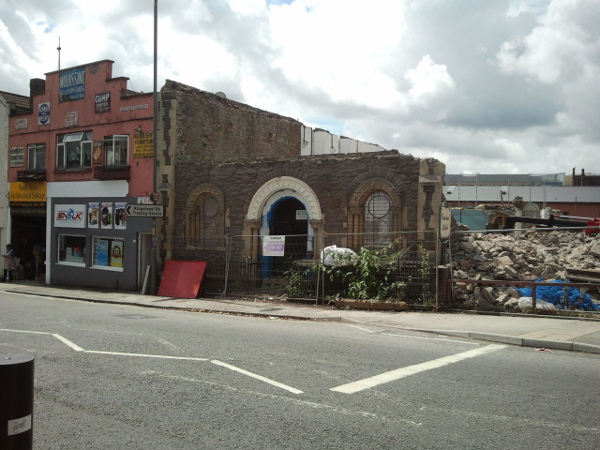Despite the best efforts of campaigners (posts passim), east Bristol is losing another part of its dwindling number of buildings of historical interest as the former Ebenezer Chapel in Midland Road in the city’s St Philips area is currently being demolished by its owners, no doubt to make way for yet more soulless ‘apartments’ of zero architectural merit (like much of Bristol’s post-war architecture. Ed.).
The building itself has had a chequered history: it opened as a Primitive Methodist chapel in 1849. Henry Overton Wills II, from the local tobacco dynasty, laid its foundation stone. It closed as a Methodist chapel in 1938 but reopened as a Christadelphian hall in 1958 after WW2 bomb damage had been repaired. It was converted into business premises in the 1980s.

I feel that the demolition has been aided and abetted by a gutless local authority which could have stepped in and refused the demolition order. Bristol City Council justified its actions by giving two reasons:
- the building is not listed; and
- the building is not in a conservation area.
The fact that the Ebenezer Chapel was neither listed nor included in the nearby Old Market Conservation Area is indicative of the abject failings of Bristol City Council as a local authority.
The chapel was the first Primitive Methodist chapel built in Bristol. Surely it deserved listing solely for that single reason?
Furthermore, unlike the more conventional Gothic style employed for chapel buildings at the time, the Ebenezer Chapel was designed with decorative round arched windows in a very rare bold Romanesque style. This should have been yet another reason for listing.
Regarding the chapel, Kathy Clark, conservation officer at the Victorian Society has said: “Ebenezer Chapel, or at least its distinctive front wall, should be reused and extended for a new use, whilst preserving a worthy piece of Bristol’s heritage. We urge Bristol Council to work for retention of the chapel.”
There’ll be no chance of that now that half the front wall has been demolished! 🙁
So, I’ll bid a sad farewell to the Ebenezer, as no doubt will the thousands of people that pass it every day, but I will end with a question to Bristol City Council: when will the historical and architectural heritage of east Bristol – traditionally a poorer and less prosperous part of the city – be given equal treatment with its counterpart in Bristol’s better-off districts?
Perhaps the city council would like to answer that question using the comment form below.








 According to yesterday’s online edition of the Bristol Post, the Department of Transport is to invest the princely sum of £168 – the largest amount it has spent on tarmac for four decades – in England’s road network.
According to yesterday’s online edition of the Bristol Post, the Department of Transport is to invest the princely sum of £168 – the largest amount it has spent on tarmac for four decades – in England’s road network.
